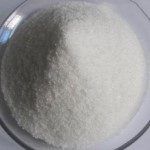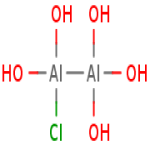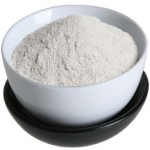Aluminum Chlorohydrate USP Grade & Aluminum Magnesium Silicate or Magnesium Aluminum Silicate BP Ph Eur USP NF Grade Suppliers Exporters, Manufacturers
Aluminum Chlorohydrate
CAS Number: Dihydrate 12042-91-0 and Anhydrous 1327-41-9, Suppliers Exporters, Manufacturers


Please visit Safety Data Sheet of Aluminum Chlorohydrate Powder Crystals USP Grade Manufacturers.
Please visit Safety Data Sheet of Aluminum Chlorohydrate Solution USP Grade Manufacturers.
Specifications of Aluminium Chlorohydrate Solution:
Appearance: Clear to yellowish hazy liquid.
Specific Gravity: 1.33 to 1.35
pH of 30% (w/w): 3.5 to 4.5
Aluminum (Al): 12.2 to 12.7%
Aluminium as (Al2O3): 23 to 24%
Chloride (Cl): 7.9 to 8.4%
Iron (Fe): 300ppm maximum
Arsenic (As2O3): 2ppm maximum
Lead (Pb): 10ppm maximum.
Specifications of Aluminum Chlorohydrate Solution USP Grade:
Aluminum Chlorohydrate Solution consists of complex basic aluminum chloride that is polymeric and encompasses a range of aluminum-to-chloride ratios between 1.91:1 and 2.10:1. The following solvents may be used: water, propylene glycol, dipropylene glycol, or alcohol. It contains the equivalent of not less than 90.0 percent and not more than 110.0 percent of the labeled concentration of anhydrous aluminum chlorohydrate.
Packaging and storage: Preserve in well-closed containers.
Labeling: Label Solution to state the solvent used and the claimed concentration of anhydrous aluminum chlorohydrate contained therein.
Identification:
A: A solution containing the equivalent of about 100 mg of anhydrous aluminum chlorohydrate per mL responds to the tests for Aluminum and for Chloride.
B: Identification of propylene glycol (where stated on the label): Add about 10 mL of isopropyl alcohol to 2 g of Solution, mix, and filter. Evaporate the filtrate to about 1 mL on a steam bath: the IR spectrum of a film of this solution on a silver chloride disk exhibits maxima only at the same wavelengths as that of a similar preparation of a film of propylene glycol.
C: Identification of dipropylene glycol (where stated on the label): Add about 10 mL of isopropyl alcohol to 2 g of Solution, mix, and filter. Evaporate the filtrate to about 1 mL on a steam bath: the IR spectrum of a film of this solution on a silver chloride disk exhibits maxima only at the same wavelengths as that of a similar preparation of a film of dipropylene glycol.
D: Identification of alcohol (where stated on the label): In a small beaker mix 5 drops of Solution with 1 mL of potassium permanganate solution (1 in 100) and 5 drops of 2 N sulfuric acid. Immediately cover the beaker with filter paper moistened with a freshly prepared solution of 0.1 g of sodium nitroferricyanide and 0.25 g of piperazine in 5 mL of water: an intense blue color is produced on the filter paper, the color fading after a few minutes.
pH: between 3.0 and 5.0, in a solution prepared by diluting 3 g of the solution with water to obtain 10 mL.
Arsenic: Prepare the Test Preparation using an accurately weighed quantity of the Solution. The limit is 2 ppm.
Heavy metals: Prepare the Test Preparation using an accurately weighed quantity of the Solution. The limit is 0.001%.
Limit of iron: To pass the test --- (75 micro-gm per g).
Content of aluminum: To pass the test.
Content of chloride: To pass the test.
Aluminum/chloride atomic ratio: --- the ratio is between 1.91:1 and 2.10:1.
Certificate of Analysis of Aluminum Chlorohydrate Powder:
Color: Off-white to Slight yellow
Appearance: Fine Powder
Aluminum (Al): 23.5 - 27.5%
Chloride (Cl): 15.5 to 18.5%
Al:Cl atomic ratio: 1.91:1 to 2.10:1
pH (15% w/w): 4.0 to 4.8
Odor: Odorless.
Specifications of Aluminum Chlorohydrate USP Grade:
Aly(OH)3y-zClz-H2O
Aluminum chlorohydroxide.
Aluminum hydroxychloride.
Dihydrate --- 12042-91-0.
Anhydrous --- 1327-41-9.
Aluminum chlorohydroxide, dihydrate.
Aluminum hydroxychloride, dihydrate.
Dihydrate --- 210.48 --- CAS 12042-91-0.
Anhydrous --- 174.45 --- CAS 1327-41-9.
Aluminum Chlorohydrate consists of complex basic aluminum chloride that is polymeric and loosely hydrated and encompasses a range of aluminum to chloride atomic ratios between 1.91:1 and 2.10:1. It contains the equivalent of not less than 90.0 percent and not more than 110.0 percent of the labeled amount of anhydrous aluminum chlorohydrate.
Identification: A solution (1 in 10) responds to the tests for Aluminum and for Chloride.
pH: between 3.0 and 5.0, in a solution [15 in 100 (w/w)].
Arsenic: 2 micro-gm per g.
Heavy metals: 0.002%.
Limit of iron: To pass the test --- (150 micro-gm per g).
Content of aluminum: To pass the test.
Content of chloride: To pass the test.
Aluminum/chloride atomic ratio: ---: the ratio is between 1.91:1 and 2.10:1.

Please visit Hazard Statement of Aluminum Chlorohydrate Powder Crystals Suppliers.
Please visit Hazard Statement of Aluminum Chlorohydrate Solution Suppliers.
Aluminum Magnesium Silicate or Magnesium Aluminum Silicate
CAS Number: 12511-31-8, 1327-43-1, 12199-37-0 or 12174-11-7, Suppliers Exporters, Manufacturers

Please visit Safety Data Sheet of Aluminum Magnesium Silicate or Magnesium Aluminum Silicate Manufacturers.
Aluminium Magnesium Silicate BP Ph Eur Grade Specifications
Ph Eur
12511-31-8
Action and use: Excipient.
DEFINITION
Mixture of particles with colloidal particle size of montmorillonite and saponite, free from grit and non-swellable ore.
Content:
aluminium (Al; Ar 26.98): 95.0 per cent to 105.0 per cent of the value stated on the label.
magnesium (Mg; Ar 24.30): 95.0 per cent to 105.0 per cent of the value stated on the label.
CHARACTERS
Appearance: Almost white powder, granules or plates.
Solubility: Practically insoluble in water and in organic solvents. It swells in water to produce a colloidal dispersion.
IDENTIFICATION
A. Fuse 1 g with 2 g of anhydrous sodium carbonate. Warm the residue with water and filter. Acidify the filtrate with hydrochloric acid and evaporate to dryness on a water-bath. 0.25 g of the residue gives the reaction of silicates.
B. Dissolve the remainder of the residue obtained in identification test A in a mixture of 5 mL of dilute hydrochloric acid and 10 mL of water. Filter and add ammonium chloride buffer solution pH 10.0. A white, gelatinous precipitate is formed. Centrifuge and keep the supernatant for identification C. Dissolve the remaining precipitate in dilute hydrochloric acid. The solution gives the reaction of aluminium.
C. The supernatant liquid obtained after centrifugation in identification test B gives the reaction of magnesium.
TESTS
pH: 9.0 to 10.0.
Disperse 5.0 g in 100 mL of carbon dioxide-free water.
Arsenic: Maximum 3 ppm.
Transfer 16.6 g to a 250 mL beaker containing 100 mL of dilute hydrochloric acid. Mix, cover with a watch glass and boil gently, with occasional stirring, for 15 min. Allow the insoluble matter to settle and decant the supernatant liquid through a rapid- flow filter paper into a 250 mL volumetric flask, retaining as much sediment as possible in the beaker. To the residue in the beaker add 25 mL of hot dilute hydrochloric acid, stir, heat to boiling, allow the insoluble matter to settle and decant the supernatant liquid through the filter into the volumetric flask. Repeat the extraction with 4 additional quantities, each of 25 mL, of hot dilute hydrochloric acid, decanting each supernatant liquid through the filter into the volumetric flask. At the last extraction, transfer as much of the insoluble matter as possible onto the filter. Allow the combined filtrates to cool to room temperature and dilute to 250.0 mL with dilute hydrochloric acid. Dilute 5.0 mL of this solution to 25.0 mL with dilute hydrochloric acid.
Lead: Maximum 15 ppm.
Loss on drying: Maximum 8.0 per cent, determined on 1.000 g by drying in an oven at 105C.
Microbial contamination:
TAMC: acceptance criterion 1000 CFU/g.
TYMC: acceptance criterion 100 CFU/g.
Absence of Escherichia coli.
Magnesium Aluminum Silicate USP NF Grade Specifications
Magnesium Aluminum Silicate is a blend of colloidal montmorillonite and saponite that has been processed to remove grit and non-swellable ore components.
The requirements for viscosity and ratio of aluminum content to magnesium content differ for the several types of Magnesium Aluminum Silicate, as set forth in the accompanying table.
| Type | Viscosity(cps) | (Al content)/(Mg content) |
| Min. ---- Max. | Min. ---- Max. | |
| IA | 0225 ---- 0600 | 0.5 ------ 1.2 |
| IB | 0150 ---- 0450 | 0.5 ------ 1.2 |
| IC | 0800 ---- 2200 | 0.5 ------ 1.2 |
| IIA | 0100 ---- 0300 | 1.4 ------ 2.8 |
Identification: Add 2 g in small portions to 100 mL of water, with intense agitation. Allow to stand for 12 hours to ensure complete hydration. Place 2 mL of the resulting mixture on a suitable glass slide, and allow to air-dry at room temperature to produce an oriented film. Place the slide in a vacuum desiccator over a free surface of ethylene glycol. Evacuate the desiccator, and close the stopcock so that the ethylene glycol saturates the desiccator chamber. Allow to stand for 12 hours. Record the Xray diffraction pattern, and calculate the d values: the largest peak corresponds to a d value between 15.0 and 17.2 angstrom units. Prepare a random powder specimen of Magnesium Aluminum Silicate, record the X-ray diffraction pattern, and determine the d values in the region between 1.48 and 1.54 angstrom units: peaks are found between 1.492 and 1.504 angstrom units and between 1.510 and 1.540 angstrom units.
Viscosity: After determining the Loss on drying, weigh a quantity of Magnesium Aluminum Silicate test specimen equivalent to 25.0 g on the dried basis. Over a period of a few seconds, transfer the un-dried test specimen to a suitable 1-L blender jar containing an amount of water, maintained at a temperature of 25 ± 2 , that is sufficient to produce a mixture weighing 500 g. Blend for 3 minutes, accurately timed, at 14,000 to 15,000 rpm (high speed). [NOTE—Heat generated during blending causes a temperature rise to above 30 .] Transfer the contents of the blender to a 600-mL beaker, allow to stand for 5 minutes, and adjust, if necessary, to a temperature of 33 ± 3 . Using a suitable rotational viscosimeter equipped with a spindle as specified below, operate the viscosimeter at 60 rpm for 6 minutes, accurately timed, and record the scale reading. For Type IA, use a spindle having a cylinder 1.87 cm in diameter and 0.69 cm high attached to a shaft 0.32 cm in diameter, the distance from the top of the cylinder to the lower tip of the shaft being 2.54 cm, and the immersion depth being 5.00 cm (No. 2 spindle); if the scale reading is greater than 90% of full-scale, repeat the measurement, using a spindle similar to the No. 2 spindle but having the cylinder 1.27 cm in diameter and 0.16 cm high instead (No. 3 spindle). For Type IC, use a No. 3 spindle; if the scale reading is greater than 90% of full-scale, repeat the measurement using a spindle consisting of a cylindrical shaft 0.32 cm in diameter and having an immersion depth of 4.05 cm (No. 4 spindle). For Types IB and IIA, use a No. 2 spindle.
Microbial limits: Its total aerobic microbial count does not exceed 1000 cfu per g, and it meets the requirements of the test for absence of Escherichia coli.
pH: between 9.0 and 10.0, in a suspension (5 in 100) in water.
Loss on drying: Dry it at 110C to constant weight: it loses not more than 8.0% of its weight.
Acid demand: After determining the Loss on drying, weigh a quantity of Magnesium Aluminum Silicate equivalent to 5.00 g, and disperse in 500 mL of water with the aid of a suitable blender fitted with a 1-liter jar. Using a stopwatch, designate zero time. With constant mixing, add 3.0-mL portions of 0.100 N hydrochloric acid at 5, 65, 125, 185, 245, 305, 365, 425, 485, 545, 605, 665, and 725 seconds, and add a 1.0-mL portion at 785 seconds. Determine the pH potentiometrically at 840 seconds: the pH is not more than 4.0.
Arsenic: The limit is 3 ppm.
Lead: To pass the test The absorbance of the Test preparation is not greater than that of the Standard preparation (0.0015%).
Assay for aluminum and magnesium content: To pass the test.

Please visit Hazard Statement of Aluminum Magnesium Silicate Suppliers.
Aluminum Chlorohydrate CAS Number Dihydrate 12042-91-0 and Anhydrous 1327-41-9 & Aluminum Magnesium Silicate or Magnesium Aluminum Silicate CAS Number 12511-31-8, 1327-43-1, 12199-37-0 or 12174-11-7 Supplier Exporter, Manufacturer:
Annie Chemie P Ltd
Mumbai 4000010, INDIA
With Agents and offices in UAE, USA, Europe.
e-mail: info@anniechemie.com
Copyright and Usual Disclaimer is Applicable.
June 3, 2025
Exporters to USA, Canada, UK, Europe, UAE, Nigeria, Algeria, Turkey, Mexico, Brazil, Chile, Argentina, Australia, Dubai etc.
Perfection is made up of small things and that is a big thing.
